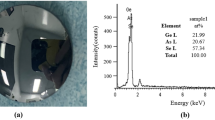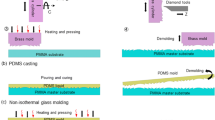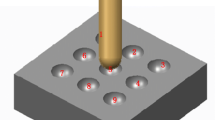Abstract
Recently, with increasing lightness and miniaturization of high resolution camera phones, the demand for aspheric glass lens has increased because plastic and spherical lenses are unable to satisfy the required performance. An aspheric glass lens is fabricated by high temperature and pressure molding using a tungsten carbide molding core; so precision grinding and coating technology for the molding core surface is required. In this paper, Aspheric glass lens for 5 megapixel 4 time zoom camera phone modules was developed. The grinding condition of the tungsten carbide molding core was found after applying design of experiments (DOE). Also, the ultra-precision grinding process was investigated under this condition by experiment. Rhenium-iridium (Re-Ir) coating was applied on the ground surface of the tungsten carbide molding core. The influence of Re-Ir coating was compared and evaluated. The surface roughness of the molding core were improved by application of Re-Ir coating on the surface of the tungsten carbide molding core. Aspheric lenses were also molded with the non-coated molding core and the Re-Ir coated molding core. The surface roughness of the aspheric glass lens improved by about 0.4 nm (aspheric surface) and 0.5 nm (plane surface).
Similar content being viewed by others
References
Suzuki, H., Kodera, S., Naksuji, T., Ohta, T. and Syoji, K., “Precision Grinding of Aspherical CVD-SiC Molding Die,” Int. J. Japan Soc. Prec. Eng., Vol. 32, No. 1, pp. 25–30, 1998.
Lee, J. S. and Syoji, K., “A study on ultra precision machining for aspherical surface of optical parts,” Journal of the KSPE, Vol. 19, No. 10, pp. 195–201. 2002.
Yin, S., Ohmori, H., Uehara, Y., Shimizu, T. and Lin, W., “Micro v-grooves grinding technique of large germanium immersion grating element for min-infrared spectrograph,” JSME Int. Journal. Ser. C., Vol. 47, No. 1, pp. 56–65, 2004.
Yin, S., Morita, S., Ohmori, H., Uehara, Y., Lin, W., Liu, Q., Maihara, T., Iwamuro, F. and Mochida, D., “ELID precision Grinding of Large Special Schmidt Plate for Fibre Multi-object Spectrograph for 8.2m Subaru Telescope,” International Journal of Machine Tools & Manufacture, Vol. 45, No. 14, pp. 1598–1604, 2005.
Saleh, T., Biswas, I., Lim, H. S. and Rahman, M., “In-process Truing of Metal-bonded Diamond Wheels for Electrolytic In-process Dressing (ELID) Grinding,” International Journal of Precision Engineering and Manufacturing, Vol. 9, No. 3, pp. 3–6, 2008.
Ahn, D. K. and Lee, S. H., “Improving the Surface Roughness of SL Parts Using a Coating and Grinding Process,” International Journal of Precision Engineering and Manufacturing, Vol. 8, No. 3, pp. 14–19, 2007.
Kim, H.-U., Jeong, S.-H., Ahn, J.-H., Cha, D.-H., Lee, D.-G., Kim, S.-S., Kim, H.-J. and Kim, J.-Ho., “Optimal Grinding Condition of Tungsten Carbide(WC) for Aspheric Glass Lens Using DOE,” The Korean Society of Manufacturing Process Engineers, Vol. 5, No. 4, pp. 41–45, 2006.
Kuriyagawa, T., Yoshihara, N., Saeki, M. and Syoji, K., “Nano topography characteristic of asisymmetric aspherical grinding surface,” Key Engineering Materials, Vol. 238–239, pp. 125–130, 2003.
Alagumurthi, N., Palaniradja, K. and Soundararajan, V., “Optimization of Grinding Process Through Design of Experiment(DOE),” Materials and Manufacturing Processes, Vol. 21, No. 1, pp. 19–26, 2006.
Lee, E. S. and Back, S. Y., “A Study on optimum grinding factors for aspheric convex surface micro-lens using design of experiments,” International Journal of Machine tools & Manufacture, Vol. 47, No. 3–4, pp. 509–520, 2007.
Chen, W. K., Kuriyagawa, T., Huang, H. and Yosihara, N., “Machining of micro aspherical mould inserts,” Precision Engineering, Vol. 29, No. 3, pp. 315–323, 2005.
Kim, H.-T., Yang, H.-J. and Kim, S.-C., “Control Method for the Tool Path in Aspherical Surface Grinding and Polishing,” International Journal of Precision Engineering Manufacturing, Vol. 7, No. 4, pp. 51–56, 2006.
Huang, H., Chen, W. K. and Kuriyagawa, T., “Profile error compensation approaches for parallel nanogrinding of aspherical mould inserts,” International Journal of Machine Tools & Manufacture, Vol. 47, No. 15, pp. 2237–2245, 2007.
Gopal, A. V. and Rao, P. V., “A new chip-thickness model ofr performance assessment of silicon carbide grinding,” International Journal of Advanced Manufacturing Technology, Vol. 24, No. 11–12, pp. 816–820, 2004.
Zhao, Q., Liang, Y., Stephenson, D. and Corbett, J., “Surface and subsurface integrity in diamond grinding of iptcal glasses on Tetraform ‘C’,” International Journal of Machine Tools and Manufacture, Vol. 47, No. 14, pp. 2091–2097, 2007.
Author information
Authors and Affiliations
Corresponding author
Rights and permissions
About this article
Cite this article
Kim, HU., Cha, DH., Kim, HJ. et al. Rhenium-iridium coating effect of tungsten carbide mold for aspheric glass lens. Int. J. Precis. Eng. Manuf. 10, 19–23 (2009). https://doi.org/10.1007/s12541-009-0042-z
Received:
Accepted:
Published:
Issue Date:
DOI: https://doi.org/10.1007/s12541-009-0042-z




